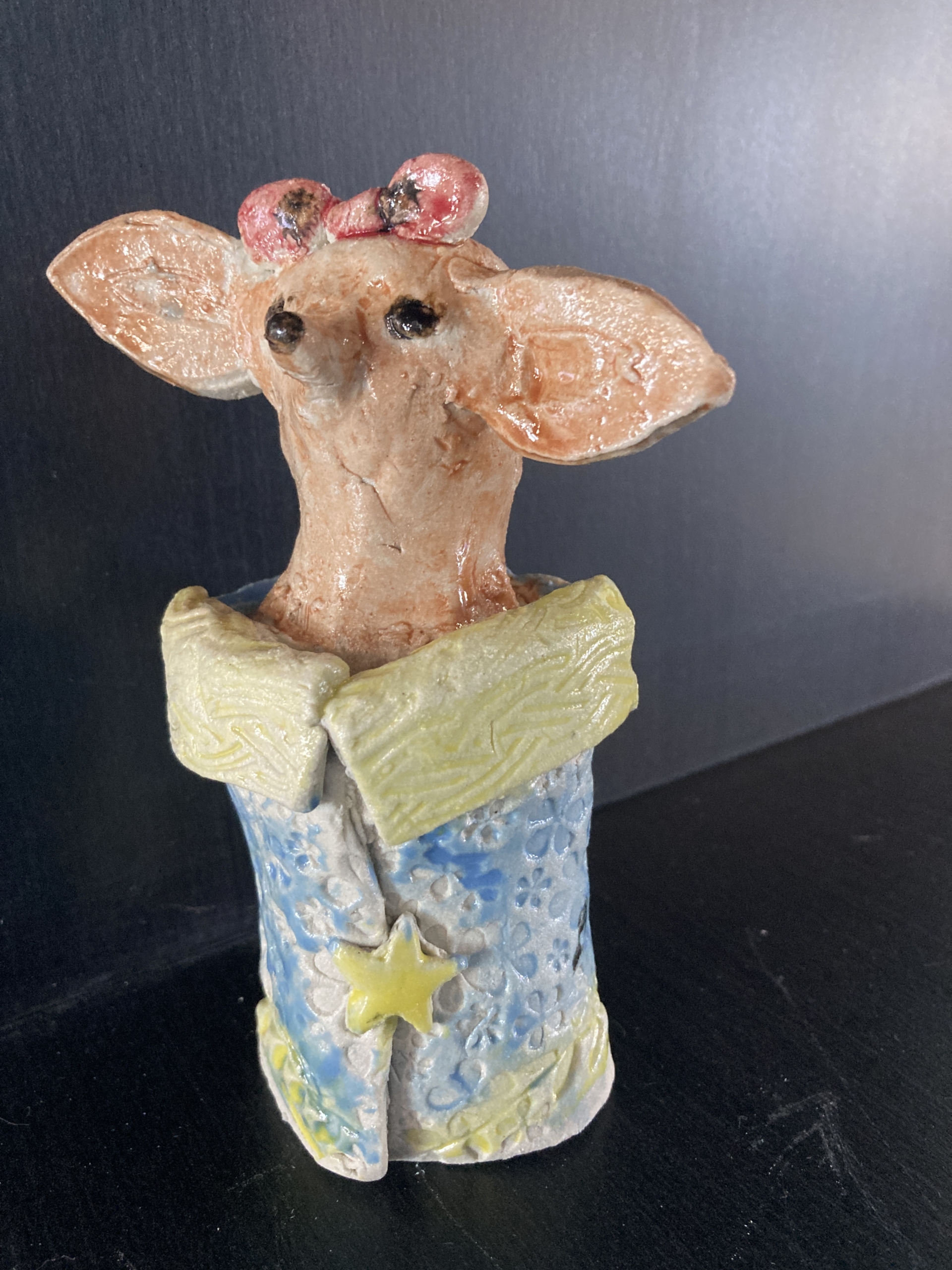Animal Figures
Meet The Teacher: Kim Fitzharris
I have been a teacher/artist for 23 years, specializing in ceramics, drawing and painting. My life as an artist works in tandem with helping children find their creative spark. We become more integrated, intelligent and compassionate human beings when we express ourselves creatively.
Project Description
Using hand building techniques to make figurative sculpture this project emphasizes artistic ideas related to nature, cultural and social/historical contexts. We look at ceremonial dress and study animal physiology.
Materials
- Mid range clay with grog (cone 4-6)
- Slab roller or rolling pin
- Wood stamps
- Sculpting tools
- Paint brushes
- Stroke Coat glazes
Grade Level
Elementary School
Difficulty
Easy
Student Hands-On Time
1.25 hours
Teacher Prep Time
1 hour
Project Cost / Cost Per Student
4
National Core Arts Standards - Visual Arts
- Creating - Generate and conceptualize artistic ideas.
- Creating - Organize and develop artistic work.
- Creating - Conceiving and developing new artistic ideas and work.
- Presenting - Select, analyze, and interpret works for presentation.
- Presenting - Develop skills for artistic presentation and exhibition.
- Responding - Perceive and analyze artistic work.
- Responding - Interpret intent and meaning in artwork.
- Responding - Evaluate and critique based on aesthetic and technical qualities.
- Connecting - Relate artistic ideas to historical, cultural, and social contexts.
- Connecting - Connect personal experiences with artmaking and meaning.
21st Century Skills
- Critical Thinking & Problem-Solving
- Creativity & Innovation
- Communication
- Collaboration
- ICT (Information, Communications, and Technology) Literacy
- Flexibility & Adaptability
- Initiative & Self-Direction
- Social & Cross-Cultural Skills
- Productivity & Accountability
- Leadership & Responsibility
STEAM Education
- Science
- Technology
- Engineering
- Arts
- Mathematics
Differentiations and Accommodations
Differentiation
IEP
Accommodation
The project may need to be simplified. Working on a tile-sized piece of clay with wood stamps is a great way for the maker to see results and feel a sense of accomplishment. Having clay available as a provocation without set parameters is sometimes the most effective therapeutic use. There is a sense of satisfaction through experimentation. Clay is an excellent tool for building sensory awareness. It’s a "go-to" medium because it allows for free expression while also helping to develop problem-solving skills.
Learning Objectives: Knowledge
The experience of developing their own vision through the medium of clay, Experience using their hands to help develop their ideas. Art as a language of expression driven by their individual interests within the themes of nature, culture and society.
Learning Objectives: Skills
Learning objectives include handbuilding basics, pinch pot construction, and surface decoration. Through these skills, kids develop an understanding of shape, form, and perspective.
Learning Objectives: Attitudes/Values
Kids gain experience expressing themselves through clay, creating unique and individual pieces. Working with clay helps kids gain confidence and have a sense of accomplishment.
Formative Assessment
Basic clay handling techniques are important for proper construction along with developing fine motor skills and problem solving skills. The nature of clay allows children a formidable challenge regardless of different levels of experience. The simple act of engaging with clay is productive whether the results are visible in terms of "learning." My philosophy as a teacher is to offer provocation as a reflective tool for the child and myself. I can better assess what an individual might need to focus on once I've observed their skill level and their ability to use clay in a manner that reflects cognitive, social and emotional intelligence.
Summative Assessment
Evaluations are a measure of success that is sometimes counterproductive to developing skills in art. If a child is engaged and willing it is enough. Allowing process before evaluating an end result is the way to evaluate true success.
Reflection and Discussion
Listening is the first step in developing a meaningful conversation. I don't offer my own opinion first but wait for the maker to share something. I then build on what is said by offering objective comments or by noticing things like differences in form or brushwork. The goal is to draw the child out and discover the story behind the work—there often is one. This can lead to interesting exchanges both within the group and one-on-one.
Lesson Activities
Animal Figures
We start the project by rolling out the clay into a flat 1/4–1/8 inch slab. We use wood stamps and drawing tools to apply surface decoration, similar to designing textiles, with attention to pattern and repetition. After they create their "fabric," they use a pattern to cut out a rectangle, which becomes the body of the animal. This piece is rolled into a cylinder shape. The head is formed like a pinch pot, then scored and slipped to attach to the main body. From there, features like ears and noses can be added, along with any decorative accessories. Kids will apply the skills they have learned, including coiling, pinching, and scoring and slipping.



